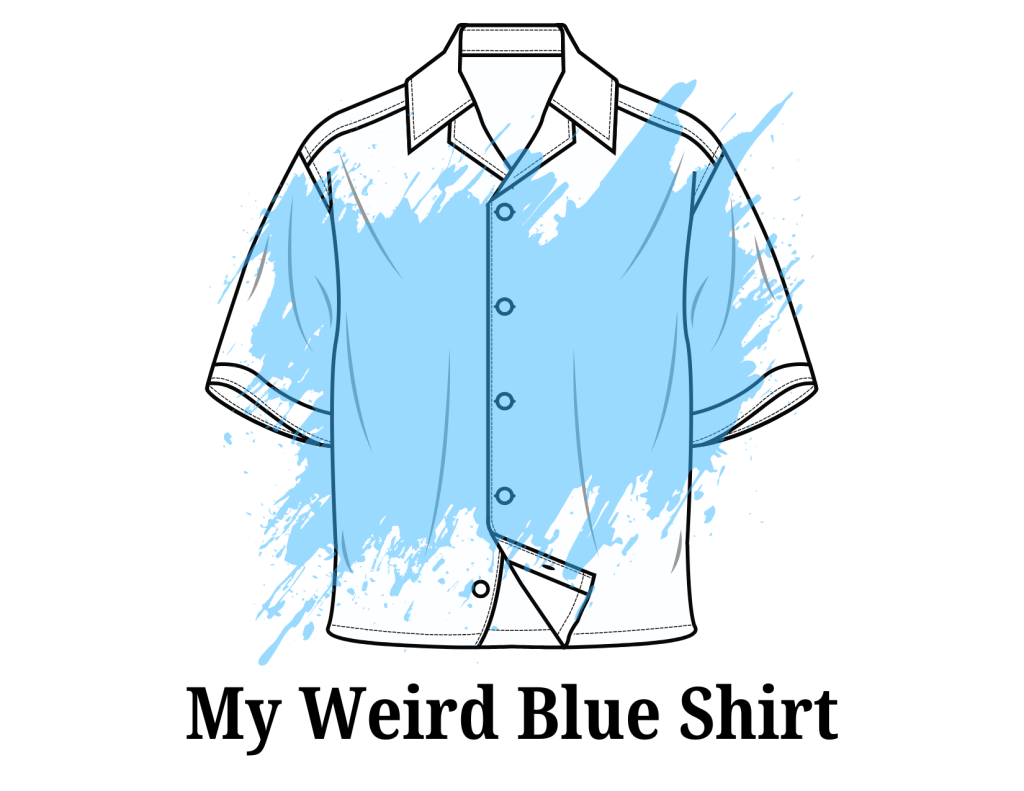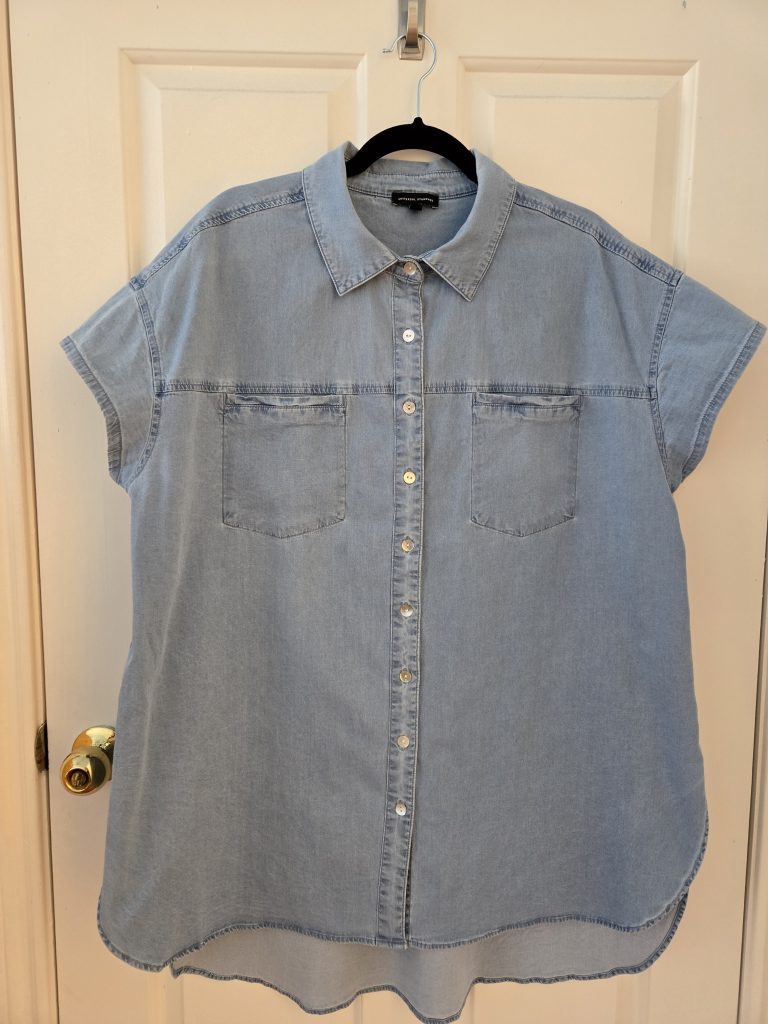

Today, I’m closing out Secondhand September with an essay about one of my own secondhand purchases that examines three different aspects of sustainable fashion through the lens of a single garment.
Part One: Impulse Shopping with My Fantasy Self
I’ve noticed a pattern over the last few years: I tend to impulse shop during times of high stress. (I’m willing to bet I’m not alone.) I’m not a recreational shopper under normal circumstances. I don’t usually overspend or overbuy, but I do make capricious purchases when I feel overwhelmed.
I was randomly searching for favorite brands on secondhand platforms during a high-stress period last summer when I came across a Universal Standard chambray shirt listed on Mercari at a ridiculously low price. I purchased it immediately. I paid $16.70 (including shipping), and although the shirt wasn’t new with tags, it had zero signs of wear. Knowing the brand, this shirt’s full retail price was probably close to $120.00, so it was a remarkable bargain.
The seller was honest in the description. She said the shirt was more oversized than she expected, so she had only worn it a couple of times. I don’t often wear blue, and I already had a blue button-up shirt. This purchase was the definition of an impulse buy; I have no idea what possessed me.
Okay, I do know. My fantasy self has been chasing the perfect chambray shirt for years now.
I bought a chambray shirt from Target in 2016 for a Rosie the Riveter costume. I expected I would donate or sell it immediately after Halloween, but I just kept… wearing it. It went with everything, and made a great outer layer when I didn’t want to wear a cardigan. It wasn’t exactly high quality, but I took care of it, and it held up well for fast fashion. I stopped reaching for it after I got sick in 2020 and it no longer fit well. I eventually gave it away, and I’ve never managed to fill the hole it left in my wardrobe.
I have plenty of button-up shirts, but none in that soft, dark, simple chambray. I sometimes think finding the right chambray shirt would fix me. I know that’s delulu. But I still feel it sometimes.
The fantasy self can convince you that if you buy the right structured handbag, you’ll have confidence. If you get the perfect bob, you’ll live an idyllic Parisian lifestyle. If you finally replace that chambray shirt you still miss, well, you will set something right in your weird, empty soul. The fantasy self is seductive.
The fantasy self lies.
These falsehoods are the creepy little tango of capitalism and insecurity. And try as I might to ignore the music, every now and then I end up dancing.
The old shirt I had loved so much had been a standard long-sleeved button-up style in dark blue chambray. The shirt from Mercari was a light blue oversized tunic with short sleeves and a high-low hem. I could see from the photos that it wasn’t an equivalent shirt. In fact, it was clearly a weird shirt – objectively unusual. I half regretted the purchase by the time the package arrived.
And yet, I started wearing the weird shirt.
The worst thing about impulse purchases is that they sometimes work. It would be easier to stop impulse shopping if all impulse purchases were mistakes.
Part Two: Mid-Range Clothing Is an Endangered Species
There’s a blog post from 2013 that lives rent-free in my head. I found it on the Wayback Machine, so you can read it if you’d like, but I’ll summarize it here. The post was about the decline of mid-range clothing as demonstrated by a vintage dress from the 1960s. The dress had details that we would consider extremely high-end nowadays – a bias-cut bodice, double welt pockets, a lapped zipper, French darts, blind hems – but it was from Sears. Sears! Truly high-quality clothing was available from almost every retailer at the time.
Though the process was already underway, that 2013 blog post was written before virtually all mainstream clothing retailers fully embraced the fast fashion cycle. It was easier to find medium-quality clothing ten to fifteen years ago, but even then, it was becoming rare. Now it’s almost extinct.
For the most part, clothing available now is either disposable slop or high-end – there’s only a tiny sliver of middle ground. But my weird shirt is firmly from the vanishing mid-range tier.
My shirt isn’t a true high-end piece, but it has wonderful details. It features chest pockets that are topstitched to mimic standard patch pockets, but they’re single-welt pockets like you see on higher-end trousers. That detail takes skill and extra time to sew. The original buttons were sewn on with a simple shank method – kind of a compromise between machine-sewn buttons and tailoring. (To be fair, the shanks had to be applied by hand, so it was definitely a higher-end finish.) The shirt’s topstitching is straight and careful, even along the deeply curved hem. Care was taken in the construction of this garment. There are also snaps included between the buttons over the chest, which I think are a typical finishing touch on all Universal Standard button-up shirts. (It can eliminate or reduce gapping due to larger bust size on closer-fitting garments, and you almost never see it on ready-to-wear, even in plus sizes.)
The fabric is an odd stretch chambray – slightly heavier than standard chambray but too light and the wrong weave to be considered denim. It’s cotton with a small amount of elastane added, and the fabric has a good hand and a decent drape for such a beefy fabric. It’s so soft and luxurious, especially for a fabric that visually mimics workwear. There was obvious care taken in the fabric choice.
You may see the phrase “elevated details” thrown around in fashion spaces. My weird shirt is exactly what they mean. It was well-made using quality materials, and the design itself suggests a fashion-forward mindset.
My weird shirt’s construction suggests an attention to detail that’s often lacking in ready-to-wear. The welt pockets with their cheeky topstitching give an unexpected tension to the garment by juxtaposing a tailoring detail with chambray fabric. This feels almost like a fashion in-joke, a kind of poke in the ribs for people who speak garment symbolism. Someone actually designed this shirt. They made intentional, creative choices that were worked into the final garment. That’s rare now.
In the race to the fast fashion bottom, manufacturers use cheaper materials, eliminate expensive-to-sew details to save on labor costs, omit trims and buttons, and squeeze the factories and workers who actually make our clothes. Finding a piece that bucks the trend, especially one produced within the last several years, feels almost like time travel.
My shirt may be weird, but it’s representative of a dying tradition of quality craftsmanship.
Part Three: Making Lemonade
I was wearing my weird blue shirt pretty regularly, but it never looked quite right to me. It took me a few months to realize that my main objection was to the buttons.
I never wear brown or tan clothing – and the original buttons were brown and tan. I decided to replace them with simple shell buttons from Wawak.
The new shell buttons had two holes instead of four, so I alternated their orientation between horizontal and vertical when I sewed them on. No one will notice this detail but me; I did it purely for my own enjoyment, though it felt like a counterpoint wink to the pocket design. I also think the shell buttons build on the friction present in the shirt’s design, acting as a nod to mother-of-pearl snaps on western work shirts. I hope I built on what was inherent in the design, or at least didn’t detract from what was already present.
Sustainable fashion people say, “The best clothes are the ones you already have,” but not every garment is an unmitigated joy. Some are placeholders that end up lasting for years because “good enough for now” becomes “eh, good enough.” We all compromise on clothing – especially those of us who aren’t straight-sized or filthy rich. Sometimes you buy a weird shirt on a whim, but instead of immediately tossing it when it doesn’t meet your expectations, the more sustainable choice is to find a way to make it suit you better.
I made lemonade out of my weird shirt. It wasn’t the chambray shirt of my dreams, but by switching out the buttons, I managed to make it more appealing. Will this be my favorite shirt? Honestly, probably not. But I genuinely like it more than I did, and I’m more excited to pull it out of my closet and wear it. It was well worth the few dollars I spent on new buttons and the hour of my time I spent sewing them on.
Even weird shirts bought on impulse can be improved with a little added effort. Try to see the potential in your own oddball garments, and if you don’t have the skills to change them, ask a friend to help or seek out a tailor.
Conclusion: Change Your Clothing Mindset
Sometimes a blue shirt is just a blue shirt, but sometimes a shirt can start an entire conversation.
I know that not everyone loves clothing and fashion as much as I do. I get that. But we all wear clothes. The massive environmental damage of overconsumption driven by fast fashion affects all of us, whether we realize it or not. According to the Circularity Gap Report, we’ve consumed 75% of the raw materials we consumed in the entire 20th century – within the past six years. This is absolutely unsustainable by any definition. It’s madness.
Clothing shouldn’t be disposable; clothing is valuable. We need to recognize that value and behave accordingly. Most of us won’t stop acquiring clothing. The key is to slow the churn. Choose secondhand first. Buy fewer items (of higher quality if you can find them and afford them), and wear them longer. Repair your clothes. Launder them carefully. Alter them to fit better and suit your tastes. Normalize re-wearing outfits. Rehome your unwanted but wearable clothing with care, rather than throwing it away, whenever possible.
I challenge you to embrace your own “weird shirt,” whatever it may be, and wear it proudly for years to come.


I hope you enjoyed the Secondhand September pieces, even if this last one was a bit of a journey. I told a friend, “I wrote a 2000 word essay about a shirt. Do you think that’s too much?” And they said, “Your readers already know what they signed up for, so no, it’s probably the exact right amount.”
Speaking of things you know you’re signed up for…
Halloween is almost here, and that means a ton of content is coming your way! Expect the first Spooky Season post to hit your inbox on the 1st, with more (lots more) to follow. In addition to the essays you already expect, I’m including a weekly piece of seasonally appropriate flash fiction this year. (Oooooh!)
Let’s get spooky! I’m more than ready. OKAY, BYE! 🖤
Leave a Reply to Sarah L. Crowder Cancel reply